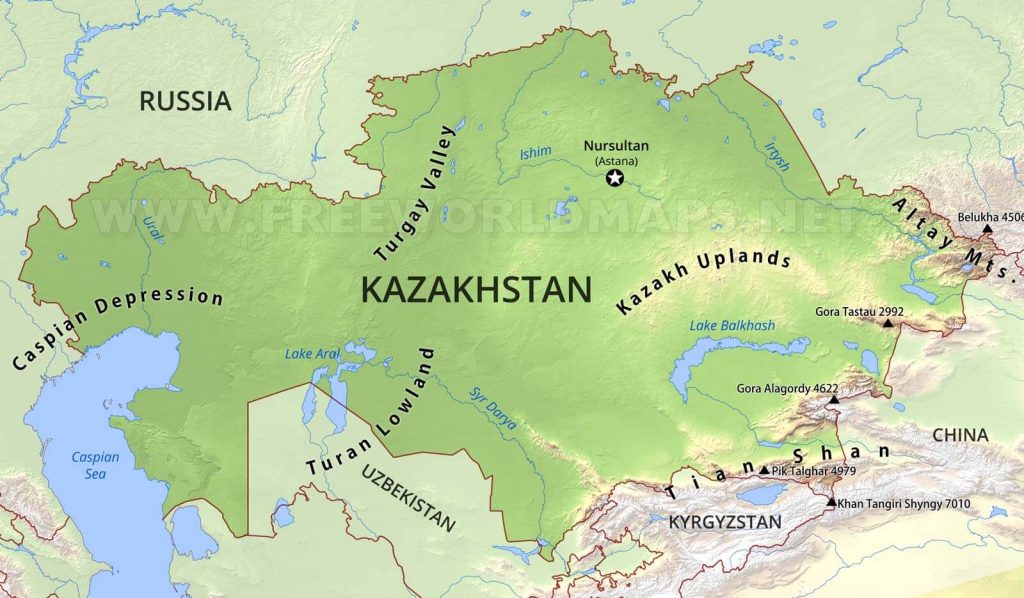
Kazakhstan Climbing Tours
Our Kazakhstan Trips
With vast plains and steppes, soaring mountains and ancient culture, Kazakhstan is the 9th largest country in the world and arguably the most economically successful of the Central Asian countries, which are collectively known as the ‘stans’. A vast oil reserve has helped create modern metropolises, while the south of the land borders the peaks and glaciers of the Tien Shan range and beautiful desert and steppe.
Speak to a Kazakhstan Expert
Gavin started Adventure Alternative in 1991 during a long period of travelling the world, working in a wide variety of jobs, climbing mountains and going on long expeditions. A six month solo trek across the Sahara Desert aged twenty one was the benchmark experience, after which travel and adventurous exploits became a way of life.
Born in the United Kingdom, Gavin went to high school in Western Australia and then moved to Northern Ireland to complete his BA in English Literature. He...
Key Facts
| Capital | Astana (Nur Sultan) |
| Government | Republic |
| Population | ~ 20 million (7 per sq km) |
| Area | 2,724,900 sq km (5x the size of France) |
| Borders | Russia, China, Mongolia, Turkmenistan, Uzbekistan, Kyrgyzstan, Caspian Sea |
| Highest peak | Khan Tengri (6995m) (Lat 42.21, Long 80.17) |
| Currency | Kazakh Tenge (KZT) |
| Language | Kazakh and Russian. Some English in the cities. |
| Religion | Islam (predominantly Sunni Muslim) |
| Coronavirus | Latest statistics |
Map Of Kazakhstan

Kazakhstan has plenty of natural wonders and is less frequented by tourists so it appeals to the adventurous traveller who can visit the huge mountains and the valleys of the Tien Shan, and also the cities of Almaty and Astana.
Almaty used to the be the capital and enjoys a great setting between mountains and plains with a history of cool architecture and exciting nightspots, while Astana is following closely with its space age buildings in view of the northern steppe.
Most of the country is steppe, the sand deserts of Kara Kum and Kizilkum, with the Tien Shan and Altai mountains in the southeast. Lake Balkhash is the largest in the land since the Aral Sea dried up.
Best Time To Visit
Kazakhstan has a continental climate with hot summers and cold winters, and a fairly dry climate. For mountaineering the best months to climb are during the summer.
Getting To Kazakhstan
There are two main airports – Almaty and Nur Sultan – which are serviced by the state airline Air Astana direct from the UK. Flight time is around six and half hours.
Astana International Airport (TSE) is 4 miles from the capital Astana. Almaty Airport (ALA) is 9 miles north of Almaty and the closest airport to reaching Khan Tengri.
Visas For Kazakhstan
There are no visas required for entry by British, Australian, Canadian, American and other EU passport holders up to 30 days. Other nationals should check with their nearest embassy. Passports should be valid for six months beyond the date of entry.
Health Requirements For Entry To Kazakhstan
Hepatitis A, Diphtheria, Tetanus, Typhoid are recommended. Yellow fever is only needed if travelling from an infected area. Anti malarial tablets are not required.
Hepatitis B,C and E and tuberculosis do occur and tick-borne encephalitis occurs in the mountain and forest regions, especially in early summer.
There is a good network of hospitals in the capital cities including the Cental Hospital in Almaty, and we recommend comprehensive medical insurance for travellers.
All water used for drinking, brushing teeth or making ice should be boiled or treated. Dairy products are safe for consumption, and only eat well cooked fish and meat.
Money
The Kazakh Tenge can only be bought in Kazakhstan and conversion back into hard currency will be hard. Generally it is best to travel with US dollars – cash or travellers cheques – and exchanged when necessary at a foreign exchange.
Major credit cards are accepted in the cities in larger hotels and shops and you can withdraw cash from ATMs. Outside the main cities it is best to carry local cash.
Power Supply
Kazakhstan has a 220V/50Hz supply and two types of electrical plugs are used, type C and F. Type C has two round pins and is known as the standard Euro plug, and type E has two round pins with two earth clips on the side.


